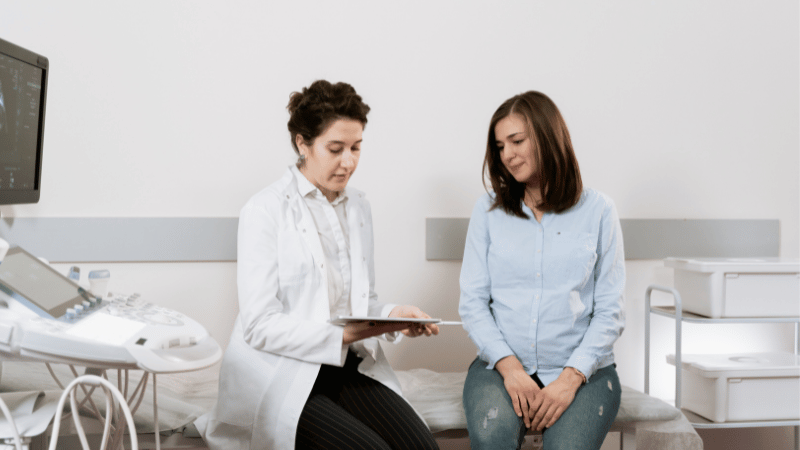
Passing blood clots during your period is often a normal part of menstruation, especially on heavier days, as the body sheds the uterine lining. These clots are typically small in size.
However, if you’re noticing larger period blood clots, particularly those bigger than a grape, or experiencing heavy bleeding, it could be more than just a heavy period. These symptoms might indicate an underlying condition such as uterine fibroids, common non-cancerous growths that can significantly disrupt your menstrual cycle. Concerned that fibroids might be affecting your periods? Take a moment to check your symptoms with our quick assessment tool.
In this blog, we’ll take a closer look at what normal period blood clots look like, when they might be a cause for concern (like with fibroids), and how these and other health conditions can impact your menstrual cycle.
What Causes Blood Clots During Menstruation?
Menstrual blood clots typically appear as dark red or maroon masses with a thick, gel-like consistency. They often form when blood pools in the uterus or vagina and begins to thicken before passing through the cervix.
Various factors can lead to blood clots during your period, ranging from hormonal shifts to structural changes in the uterus, including:
| Condition | Impact on Menstrual Cycle |
| Uterine Fibroids | Can cause heavy, prolonged periods with frequent clotting. It may also lead to pelvic pressure and fatigue from blood loss. |
| Adenomyosis | Often results in heavy menstrual bleeding, severe cramps, and the passage of period blood clots. |
| Hormonal Imbalance | (e.g., PCOS, hypothyroidism, perimenopause) Can lead to irregular ovulation and a thickened uterine lining, causing heavy shedding and period clotting. |
| Pregnancy Complications | Vaginal bleeding or clotting during pregnancy is not a normal period and requires immediate medical attention as it may signal a miscarriage or other serious issue. |
| Endometriosis | May cause clotting, severe cramps, and abnormal bleeding both during periods and at other times in the cycle. |
| Cancer (Uterine or Cervical) | Can lead to irregular bleeding, including heavier periods or bleeding between periods, and may increase clotting. |
Along with these conditions, aspirin, over-the-counter pain relievers, and medications like blood thinners can affect how your body controls bleeding and clot formation, potentially increasing the risk of passing clots during your period. Consulting a specialist can help determine whether uterine fibroids or other conditions are causing your symptoms.
Are Blood Clots Normal During a Period?
Small blood clots during your period are usually normal and experienced by most women, particularly on heavier flow days, resulting from the body’s process of shedding the uterine lining.
What Do Large Blood Clots During Your Period Mean?
Blood clots larger than a quarter, especially if they occur frequently, can indicate abnormal menstrual bleeding. These large blood clots during your period may result from hormonal imbalances that affect how the uterine lining breaks down and sheds. Larger period blood clots may be linked to physical changes in the uterus, such as fibroids or adenomyosis, that interfere with normal blood flow.
Signs Your Period Blood Clots May Not Be Normal
Occasional clotting can be a natural part of your menstrual cycle, especially on days with heavy flow. However, when clots are frequent or accompanied by other symptoms, they may indicate that something more serious is occurring.
These signs include:
- Bleeding lasts longer than 7 days.
- Soaking through pads/tampons in under 2 hours.
- Symptoms of fatigue or anemia can result from blood loss.
- Severe pelvic pain or pressure in addition to clots.
Experiencing these symptoms along with menstrual blood clots could be signs of conditions like uterine fibroids, adenomyosis, or other reproductive health concerns that warrant medical evaluation.
The Connection Between Fibroids and Period Blood Clots
If you’re passing large blood clots during your period, uterine fibroids could be the underlying cause. These growths can alter the way your uterus sheds its lining, leading to increased blood flow and clotting.
In particular, submucosal fibroids that grow just beneath the uterine cavity’s lining are most commonly associated with heavy bleeding and significant clot formation. Along with a heavy menstrual flow with blood clots, fibroids can also cause intense pelvic cramping and fatigue due to blood loss.
Other common fibroid symptoms may include:
- Pelvic pressure or fullness
- Frequent urination
- Constipation or bloating
- Pain during intercourse
- Prolonged or irregular periods
If you’re experiencing these symptoms along with period blood clots, it may be time to explore whether fibroids are the cause.
Concerned about Period Blood Clots? When to See a Fibroid Specialist
If you’re experiencing large or frequent blood clots during your period, consult a fibroid specialist for an evaluation. Diagnostic tools, such as a pelvic exam, ultrasound, or MRI, can help identify fibroids or rule out other potential causes, including endometrial polyps, hormonal imbalances, or blood clotting disorders. If left untreated, fibroids can continue to grow and lead to worsening symptoms, including increasing pain, anemia, and fertility issues.
Get Relief from Heavy Bleeding & Period Blood Clots
If you experience a heavy menstrual flow with blood clots, there are effective treatment options that can offer relief. One of the most advanced is uterine fibroid embolization (UFE), a minimally invasive, outpatient procedure. UFE works by gently reducing blood flow to fibroids, which causes them to shrink over time and reduces symptoms like heavy bleeding and clot formation. UFE preserves the uterus and offers a shorter recovery time compared to surgery, with most patients able to go home the same day they receive treatment. Most major insurance plans, including Medicare and Medicaid, also cover uterine fibroid embolization.
USA Fibroid Centers offers expert care at clinics nationwide, making it easier than ever to get the help you need. Our fibroid specialists are trained to diagnose and treat fibroids through uterine fibroid embolization (UFE).
Don’t let painful and disruptive menstrual symptoms interfere with your life any longer. Regain your confidence and comfort with the proper treatment.
Call Now to Speak With a Fibroid Specialist
FAQs About Blood Clots During Your Period
Are Period Clots Different After Childbirth?
Period clots can be different after childbirth, especially during the early postpartum period. Right after delivery, heavy periods with blood clots are normal, but typically lessen as the uterus returns to its normal size and your regular cycle returns.
Does Age Affect the Frequency or Size of Period Clots?
Age can significantly impact the size and frequency of period blood clots, especially during perimenopause. Along with hormonal changes, conditions such as uterine fibroids and polyps become more prevalent during a woman’s reproductive years and cause abnormal bleeding and clot formation.
What’s the Difference Between a Clot and Tissue During Menstruation?
Clots and tissue clumps during menstruation differ as period blood clots are solid masses formed when menstrual blood coagulates, mainly from blood cells and clotting proteins. Tissue clumps are portions of the endometrial lining that naturally shed during your cycle, which may appear fleshy or jelly-like and are often mixed with blood.





